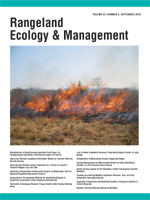Leafy spurge (Euphorbia esula L.) is an aggressive exotic species that has been successfully suppressed in a variety of situations using classical biological control (flea beetles; Aphthona spp.). This 9-yr study investigated patterns of vegetation responses following significant reductions in leafy spurge cover and density by flea beetles in southeastern Montana. We hypothesized that the vegetation following leafy spurge suppression would be dominated by species and plant functional groups able to persist through heavy infestations. Flea beetles were first released in 1998, and by 2006 leafy spurge foliar cover was reduced 80% to 90% compared to 1998 values on both release and nonrelease plots. Although total cover of the resident vegetation, excluding leafy spurge, increased 72% to 88%, relative cover of the functional groups (native forbs, native sedges, native grasses, and non-native species) was similar among years and between release and nonrelease plots. Mean diversity and mean species richness values did not differ among years or between release and nonrelease plots (P < 0.05), but mean diversity on both release and nonrelease plots was significantly less than noninfested plots, although richness was similar (P < 0.05). Indicator species analysis revealed that non-native Poa spp. replaced leafy spurge as the dominant species on release and nonrelease plots. Conversely, noninfested plots contained a variety of native species with high indicator values. Although total abundance of the resident vegetation in 2006 was significantly greater than 1998, plant species composition and relative cover showed little change for the duration of the study. Failure of the native vegetation to recover to a community that approached nearby noninfested conditions may be attributed to a variety of interacting scenarios, some of which may be ameliorated by treating infestations as soon as possible to avoid long-term residual effects.
How to translate text using browser tools
Jack L. Butler,
Stefanie D. Wacker
biological weed control
Euphorbia esula
exotic invasive
flea beetle
Northern Great Plains
restoration ecology





